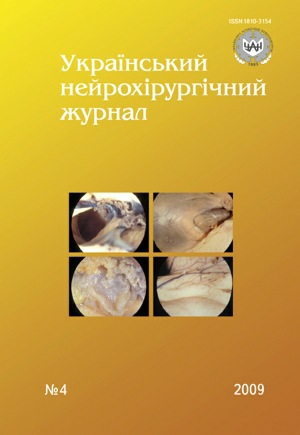Surgical treatment of intraventricular hemorrhage using external cerebrospinal fluid draining
DOI:
https://doi.org/10.25305/unj.108012Keywords:
hemorrhagic stroke, intraventricular hemorrhage, endolumbar extracorporeal CSF drainage, ventricular extracorporeal CSF drainageAbstract
The complex examination and treatment of 245 patients with acute hemorrhagic stroke, complicated with intraventricular hemorrhage were provided. At 67 (27.3%) patients just conservative therapy was applied, in 32 (13%) — open surgical interventions without cerebrospinal fluid (CSF) drainage were performed, at 5 (2%) — extracorporeal ventricular draining was used, at 71 (29%) — endolumbar extracorporeal draining, at 50 (20.4%) — a combination of open intervention with endolumbar draining, at 5 (2%) — ventricular draining in combination with open surgery, at 11 (4.5%) — ventricular CSF draining in combination with endolumbar draining, at 4 (1.6%) — open intervention, endolumbar drainage and ventricular shunting. Endolumbar extracorporeal CSF draining appeared to be most effective — in 52.2% cases positive result was obtained, at combination of CSF drainage with other options of surgical treatment — in 32.1%.
References
Варакин Н.Я. Эпидемиология сосудистых заболеваний головного мозга / Очерки ангиологии. Под ред. З.А. Суслиной. — М.: Атмосфера, 2005. — С.66 –83.
Виничук С.М., Пустовая О.А., Прокопив М.М. и др. Внутримозговое кровоизлияние: факторы определяющие тяжесть состояния и исход заболевания // Укр. мед. часопис. — 2007. — Т.5, №61. — С.25–31.
Крылов В.В., Дашьян В.Г. Выбор метода хирургического лечения гипертензивных гематом // Нейрохирургия. — 2005. — №2. — С.10–16.
Лебедев В.В., Крылов В.В. Неотложная нейрохирургия: Руководство для врачей. — М.: Медицина, 2000. — 586 с.
Міщенко Т.С., Лекомцева Є.В. Аналіз розповсюдженості, захворюваності та смертності від цереброваскулярних захворювань в Україні // Перший нац. Конгр.: “Інсульт та судинно-мозкові захворювання” (14–15 вер. 2006 р., Київ): Матеріали конгресу. — К., 2006. — С.13–14.
Пирадов М.А. Геморрагический инсульт, новые подходы к диагностике и лечению // Рус. мед. журн. — 2005. — Т.13, №14. — С.1–5.
Полишук М.Є., Дибкалюк С.В. Деякі прогностичні критерії результатів лікування хворих молодого та середнього віку з нетравматичними внутрішньо мозковими крововиливами // Лік. справа. — 2003. — №5–6. — С.57–60.
Практическая нейрохирургия: Руководство для врачей / Под. ред. Б.В. Гайдара. — СПб.: Гиппократ, 2002. — 648 с.
Симанов Ю.В., Тройников В.Г., Гербер Ю.М., Бывальцев С.Н. Наш опыт хирургического лечения больных с гипертензивными внутримозговыми кровоизлияниями // Нейрохирургия. — 2004. — №4. — С.21–26.
Щербаков П.Н., Матвеев А.С., Щербакова В.В. Хирургическое лечение внутримозговых гематом у больных с геморрагическим инсультом // Сосудистые заболевания головного и спинного мозга (19–20 сент.2000 г., Омск): Материалы наук.-практ. конф. — Омск, 2000. — С.129–133.
Adams H.P., Torner J.C., Kassell N.F. Intraventricular hemorrhage among patients with recently ruptured aneurysms: a report of the cooperative aneurysm study // Stroke. — 1992. — V.23. — P.140.
Brown D.L., Morgenstern L.B. Stopping the bleeding in intracerebral hemorrhage // New Engl. J. Med. — 2005. — V.325, N8. — P.828–830.
Daverat P., Castel J.P., Dartigues J.F., Orgogozo J.M. Death and functional outcome after spontaneous intracerebral hemorrhage // Stroke. — 1991. — V.22. — P.1–6.
De Weerd A.W. The prognosis of intraventricular hemorrhage // J. Neurol. — 1997. V.222. — P.45–51.
Feigin V.L. Stroke epidemiology in the developing world // Lancet. — 2005. — 365. — P.2160–2161.
Hardie K., Jamrozik K., Hankey G.J. et al. Trends in five-year survival and risk of recurrent stroke after first-ever stroke in the Perth Community Stroke Study // Cerebrovasc. Dis. — 2005. — V.19. — P.179–185.
Pia H.V. Operativ Behandlung intracerebraler and intraventricularer Blutungen // Therapiewoche. — 1974. — Bd.28. — S.3142–3144.
Downloads
Published
How to Cite
Issue
Section
License
Copyright (c) 2009 A. V. Regush

This work is licensed under a Creative Commons Attribution 4.0 International License.
Ukrainian Neurosurgical Journal abides by the CREATIVE COMMONS copyright rights and permissions for open access journals.
Authors, who are published in this Journal, agree to the following conditions:
1. The authors reserve the right to authorship of the work and pass the first publication right of this work to the Journal under the terms of Creative Commons Attribution License, which allows others to freely distribute the published research with the obligatory reference to the authors of the original work and the first publication of the work in this Journal.
2. The authors have the right to conclude separate supplement agreements that relate to non-exclusive work distribution in the form of which it has been published by the Journal (for example, to upload the work to the online storage of the Journal or publish it as part of a monograph), provided that the reference to the first publication of the work in this Journal is included.









